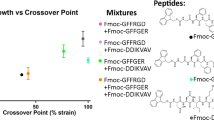Summary
Fibroblastsin vivo reside in a three-dimensional (3-D) matrix. The 3-D culture method using collagen gels provides valuable information, but is also has some practical difficulties. In particular, the changes caused by the contraction of gels and the occasional abrupt detachment from the underlying surface have made extended culture difficult. In this study, the 3-D culture method was modified in order to observe the cells with minimal change of substrata for longer periods. The proliferation characteristics of fibroblasts cultured in gels in response to fetal calf serum (FCS), to two defined growth factors, insulin and platelet-derived growth factor (PDGF), and to a growth inhibitory factor, prostaglandin E2 (PGE2), were evaluated with this system in comparison with monolayer cultured fibroblasts. The DNA content of fibroblasts cultured both in gels and on dishes increased in response to FCS in a concentration-dependent manner. The proliferation of gel-cultured fibroblasts, however, was lower than that of dish-cultured cells, and higher concentrations of serum were necessary for proliferation. The response of gel-cultured cells to PDGF was also less than that of dish-cultured cells. In addition, fibroblasts cultured in gel culture did not respond to insulin, while the fibroblasts on dishes responded to insulin in a concentration-dependent manner. In contrast to the reduced response to growth stimulators, PGE2 inhibited proliferation in gel culture and in monolayer culture similarly. The reduced responsiveness to growth stimulation but equivalent response to growth inhibition may account for reduced proliferation of fibroblasts in 3-D culture.
Similar content being viewed by others

References
Bell, E.; Ivarsson, B.; Merrill, C.. Production of a tissue-like structure by contraction of collagen lattices by human fibroblasts of different proliferative potential in vitro. Proc. Natl. Acad. Sci. USA 76:1274–1278; 1979.
Bellows, C. G.; Melcher, A. H.; Aubin, J. E.. Contraction and organization of collagen gels by cells cultured from periodontal ligament, gingiva and bone suggest functional differences between cell types. J. Cell Sci 50:299–314; 1981.
Ehrmann, R. I.; Gey, G. O.. The growth of cells on a transparent gel of reconstituted rat-tail collagen. J. Natl. Cancer Inst. 16:1375–1403; 1956.
Elsdale, T.; Bard, J.. Collagen substrata for studies on cell behavior. J. Cell Biol. 54:626–637; 1972.
Grinnell, F.. Fibroblasts, myofibroblasts, and wound contraction (minireriew on the cellular mechanisms of disease). J. Cell Biol. 124:401–404; 1994.
Grinnell, F.; Bennett, M. H.. Fibroblast adhesion on collagen substrata in the presence and absence of plasma fibronectin. J. Cell Sci. 48:19–34; 1981.
Labarca, C.; Paigen, K.. A simple, rapid, and sensitive DNA assay procedure. Anal. Biochem. 102:344–352; 1980.
Lin, Y. C.; Grinnell, F. G.. Decreased level of PDGF-stimulated receptor autophosphorylation by fibroblasts in mechnically relaxed collagen matrices. J. Cell Biol. 122:663; 1993.
Mauch, C.; Adelmann, G. B.; Hatamochi, A., et al. Collagenase gene expression in fibroblasts is regulated by a three-dimensional contact with collagen. FEBS Lett. 250:301–305; 1989.
Mochitate, K.; Pawelek, P.; Grinnell, F.. Stress relaxation of contracted collagen gels: disruption of actin filament bundles, release of cell surface fibronectin, and down-regulation of DNA and protein synthesis. Exp. Cell Res. 193:198–207; 1991.
Nakagawa, S.; Pawelek, P.; Grinnell, F.. Extracellular matrix organization modulates fibroblast growth and growth factor responsiveness. Exp. Cell Res. 182:572–582; 1989.
Nakagawa, S.; Pawelek, P.; Grinnell, F.. Long-term culture of fibroblasts in contracted collagen gels: effects on cell growth and biosynthetic activity. J. Invest. Dermatol. 93:792–798; 1989.
Nishiyama, T.; Horii, I.; Nakayama, Y., et al. A distinct characteristic of the quiescent state of human dermal fibroblasts in contracted collagen gel as revealed by no response to epidermal growth factor alone, but a positive growth response to a combination of the growth factor and saikosaponin b1. Matrix 10:412–419; 1990.
Nishiyama, T.; Tsunenaga, M.; Nakayama, Y., et al. Growth rate of human fibroblasts is repressed by the culture within reconstituted collagen matrix but not by the culture on the matrix. Matrix 9:193–199; 1989.
Nusgens, B.; Merrill, C.; Lapiere, C. M., et al. Collagen biosynthesis by cells in a tissue equivalent matrix in vitro. Collagen Relat. Res. 4:351–364; 1984.
Sarber, R.; Hull, B.; Merrill, C., et al. Regulation of proliferation of fibroblasts of low and high population doubling levels grown in collagen lattices. Mech. Ageing Devel 17:107–117; 1981.
Schor, S. L.. Cell proliferation and migration on collagen substrata in vitro. J. Cell Sci. 41:159–175; 1980.
Tomasek, J. J.; Hay, E. D.; Fujiwara, K.. Collagen modulates cell shape and cytoskeleton of embryonic corneal and fibroma fibroblasts: distribution of actin, alpha-actinin, and myosin. Dev. Biol. 92:107–122; 1982.
Author information
Authors and Affiliations
Rights and permissions
About this article
Cite this article
Mio, T., Adachi, Y., Romberger, D.J. et al. Regulation of fibroblast proliferation in three-dimensional collagen gel matrix. In Vitro Cell.Dev.Biol.-Animal 32, 427–433 (1996). https://doi.org/10.1007/BF02723005
Received:
Accepted:
Issue Date:
DOI: https://doi.org/10.1007/BF02723005



